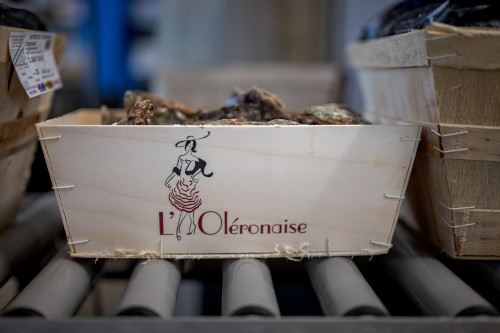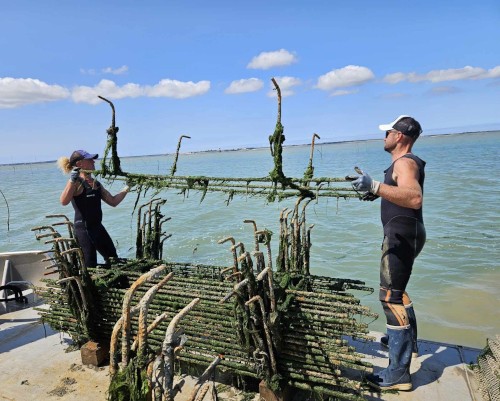A quick-to-savor yet subtly refined delicacy, the oyster's journey from hatchling to market is a lengthy and labor-intensive process that's often overlooked. Raising an oyster to full maturity for sale is a three-year endeavor. Its life, before gracing our dinner plates, involves a series of essential seasonal steps, each critical to its proper growth. Similar to a fine wine, an oyster demands time and consistent care to evolve into a truly exquisite offering.
To truly grasp the intricacies of these production steps and to possibly better understand the dedication of oyster farmers who tirelessly nurture their oysters through every season and weather condition, here's a concise rundown of the different stages in an oyster's life and the art of oyster farming.
Installing Collectors and Gathering Oyster Spat
In mid-July, we get to work on preparing and placing collectors in designated areas for capturing oyster spat. This is the time when oyster larvae, also known as spat, find their way to these collectors to settle. It's a crucial step in the natural breeding cycle, especially in the Charente-Maritime region, which is particularly dedicated to preserving the natural reproduction process of oysters.
Collecting Spat and Sorting
La vie de l'huître
Eight months down the line, it's time to lift the collectors and separate the young oysters, known as 'grattis'. This stage involves a specialized sorting process using a sieving machine. This machine is fitted with four differently sized grids, which help categorize the grattis by size through vibration. Once sorted, these young oysters are placed in fine mesh bags - about 500 per bag - and laid out on metallic tables in the oyster farms.
Cultivating Oleron Oysters
A year in, we pull up the grattis bags (it's the oysters that have grown, not the bags) for another round of sorting. The oysters are then moved into larger mesh bags to give them more room to grow and improve water circulation. Growing oysters in the intertidal zone, the area exposed during tides, boosts their resilience and strengthens their adductor muscle, helping them retain water in their shell longer.
Come the next year, around the same time, we sort the oysters again, this time using bigger grates. The bags are then laid back into the sea and will be turned around August/September.
We regularly flip and shake the bags to prevent the oysters from growing too long or getting stuck in the mesh, ensuring they develop a uniform shape.
We clear out the unused parks, removing tables to let the currents flow and stop mussel spat from gathering on them in April-May. The tables are checked and replaced if necessary, and then set back in the sea by May-June, ready for the new batches of oysters at different stages of their growth cycle.
Sizing Up Oleron Oysters
Come autumn, we haul up the oyster bags for the final time. These fresh oysters, just in from the sea, are next up for sizing before they hit the market. We sort them out, either by hand or, more typically, using a sizing machine. Here's how it works: we load the oysters onto an outdoor conveyor which leads them to a washing area, and then they move onto another sorting conveyor. Our oyster farmers get to work, prying open the shells and, if needed, using a tool to gently separate any oysters that are still clinging together. Each oyster then gets individually guided along another belt that sorts them into cups, each one getting weighed by the machine. After that, they're mechanically sorted by size. Now, the oysters are divvied up - some go into bags for aging in saltwater ponds, known as Fine de claire, while others are packed into crates for direct shipping, like the Fine or Special variety. These crates of Fines and Specials are then placed in purging tanks. These are pools of clean, oxygenated seawater designed to flush out any impurities, like sand, and to finish off their filtering process. After this, they're all set to be packaged and shipped off.
Refining and Maturing in Salt Ponds
La vie de l'huître
To create Fine de claire oysters, an additional step is crucial in their production process: maturation in salt ponds. These ponds, nestled between land and sea, are a blend of both worlds. Once salt marshes that were repurposed after the Revolution and the abolition of the salt tax, they are filled and drained with the rhythm of the tides, bringing a constant renewal of sediments.
Their naturally clayey bottoms make them impermeable, and their shallow depth allows for easier penetration of sunlight, which aids in rapid thermal exchanges - ideal for the growth of phytoplankton, the oysters' food source. The small size of these ponds promotes sedimentation from the coastal waters.
The ponds are dug and maintained annually to prevent natural filling and to curb the growth of macroalgae, which can hinder the oysters' oxygenation. Refined in these ponds for several weeks, with a limited number of bags per pond based on its size to avoid overcrowding and promote growth, Fine de claire oysters can develop a better shell quality than those grown in open sea. Depending on the chosen ponds for maturation, they may have varying levels of blue navicula, a microalgae filtered by the oysters. This algae contains marennine, a pigment that gives the oysters' gills a more intense green color. Less fleshy and balanced in salt content, their refinement results in a more subtle flavor. The taste lingers briefly in the mouth, creating a unique culinary experience.
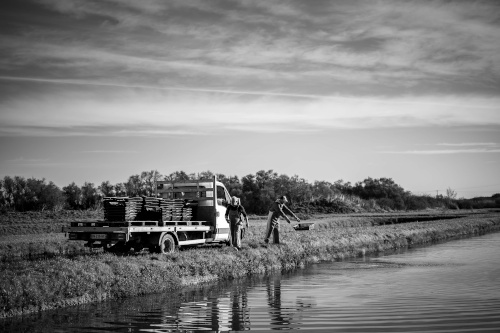
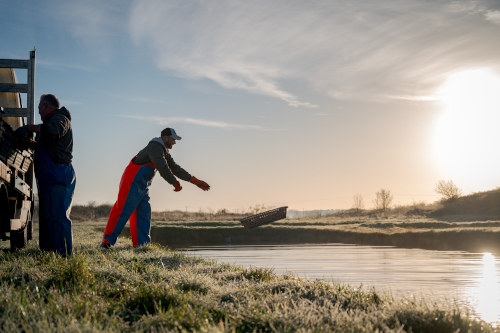
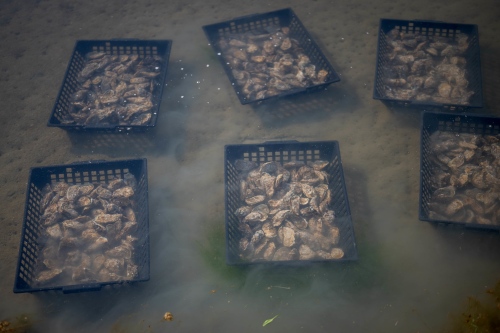
Packaging and Shipping Oysters for the Holiday Season
La vie de l'huître
While at L’Oléronaise we ship from January to December, the end-of-year holiday season is undoubtedly the peak period for the oyster industry. In fact, more than half of France's annual oyster production is shipped out during this time. Oyster sales, like any other food product, are subject to strict shipping regulations, including clear labeling requirements. To ensure product traceability, our shipping center attaches a sanitary label to each oyster basket. This label includes the sanitary number approved by veterinary services, our contact details, the mandatory legal mention, and a serial number. On the commercial part of the label, we include product details: category, size, country of origin, minimum number of oysters, and minimum weight.
The oysters are then carefully arranged in the baskets, curved side down, and securely packed to prevent movement during transport. This arrangement helps to retain their water, ensuring they arrive fresh and ready for your holiday feast.
From Farm to Table: The Craftsmanship of L’Oléronaise Oysters
La vie de l'huître
So, after three years of dedicated farming and numerous stages, L’Oléronaise oysters make their journey from spat to your plate, ready to be savored.
It's a labor of love and perseverance, shaped by the whims of tides and increasingly unpredictable weather. These challenges compel us to continually adapt our methods and evolve our techniques, all while striving to anticipate changes and preserve the tradition of our craftsmanship.
Now that you have a deeper understanding of the life of this cherished and quickly enjoyed shellfish, and the care we take to bring you the finest from our region, we hope you'll savor them with even greater enjoyment…
So, now that you grasp the nuances of our L'Oléronaise oysters, whether you're still a curious newcomer or a dedicated oyster connoisseur, you'll undoubtedly find an oyster to suit your taste. Be it a Fine or a Special, light or meaty, treat yourself to this passionately raised product that captures the richness of Oléron Island, and let yourself be charmed by its authenticity.


